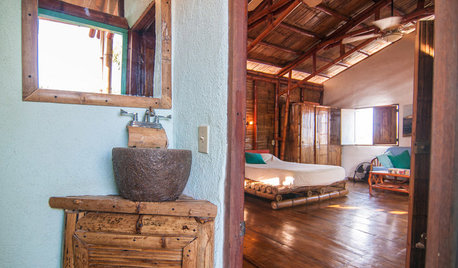frogs in the house
frogsbelongoutdoors
17 years ago
Related Stories

COLORFUL KITCHENSA Kitchen to Melt Kermit the Frog’s Heart
Despite what the song says, it’s actually easy being green, as this fresh and colorful kitchen proves
Full Story
HOUZZ TOURSHouzz Tour: Texas Family Trades Traffic Noise for Frog Songs
Modern glass and stone structures hug two waterways on a sprawling Texas Hill Country compound
Full Story
THE ART OF ARCHITECTUREFinding the Perfect Home for a New House
Sun, soil, water, topography and more offer important cues to siting your house on the land
Full Story
FUN HOUZZHouzz Call: Tell Us About Your Dream House
Let your home fantasy loose — the sky's the limit, and we want to hear all about it
Full Story
MOST POPULARWhen Does a House Become a Home?
Getting settled can take more than arranging all your stuff. Discover how to make a real connection with where you live
Full Story
LIFEDo You Live in Your Childhood House?
Tell us about the home you grew up in — whether you live there now or not — and share your pictures!
Full Story
LIFEYou Said It: ‘This House Is Keeping It Real’ and More Houzz Quotables
This week the most-popular lists surprised, and a group of magical landscapes had us dreaming of fairy tales
Full Story
GLOBAL STYLEMy Houzz: Sustainable Bamboo for a Prototype Home in Nicaragua
Ecofriendly living has a new champion, as a Granada firm kicks off its bamboo offerings with this house's architecture and furnishings
Full Story
HOUZZ TOURSMy Houzz: Feel-Good Design Energizes a 1940s Ohio Home
Saturated colors and bold prints turn a boring beige house into a cheerful, inviting family home
Full Story
COLLECTIONSWorld of Design: 9 Cool Collectors and What They Keep at Home
Meet the people behind some museum-worthy assemblages — from a house of hats in Los Angeles to dinosaur art near London
Full Story





meldy_nva
Related Professionals
Ballwin Landscape Architects & Landscape Designers · Belmont Landscape Architects & Landscape Designers · Middle River Landscape Architects & Landscape Designers · Columbine Landscape Contractors · Crystal Landscape Contractors · Fort Worth Landscape Contractors · Harrisburg Landscape Contractors · Antioch Landscape Contractors · Central Islip Window Contractors · Cocoa Beach Window Contractors · Enumclaw Window Contractors · Greenwich Window Contractors · Lemont Window Contractors · Ocean Pines Window Contractors · Sarasota Window Contractors